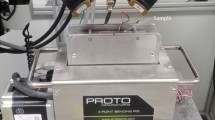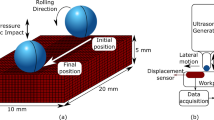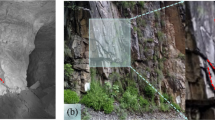Abstract
The integral method is a suitable calculation procedure for the determination of nonuniform residual stresses by semidestructive mechanical methods such as the hole-drilling method and the ring-core method. However, the high sensitivity to strain measurement errors due to the ill conditioning of the equations has hindered its practical use. the analysis of the influence of the strain measurment error on the computed stresses carried out in the present work has showed that, given both maximum hole depth and number of total steps, the error sensitivity depends on the particular depth increment distribution used. By means of the matrix formulation, the depth increment distribution that optimizes the numerical conditioning is investigated. Numerical simulations and an experimental test have corroborated the best performance of the proposed step distribution with respect to the constant or increasing distributions commonly used.
Similar content being viewed by others
References
Kelsey, R.A., “Measuring Non-uniform Residual Stresses Using the Hole-drilling Method,”Proc. SESA,14,181–194 (1956).
Nickola, W.E., “Practical Subsurface Residual Stress Evaluation by the Hole-drilling Method,” Proceedings of the 1986 SEM Spring Conference, 47–58 (1986).
Bijak-Zochoski, M.A., “Semidestructive Method of Measuring Residual Stresses,”VDI-Berichte,313,469–476 (1978).
Niku-Lari, A., Lu, J., andFlavonet, J.F., “Measurement of Residual Stress Distribution by the Incremental Hole Drilling Method,” EXPERIMENTAL MECHANICS,25,175–185 (1985).
Flaman, M.T. andManning, B.H., “Determination of Residual Stress Variation with Depth by the Hole Drilling Method,” EXPERIMENTAL MECHANICS,25,205–207 (1985).
Schajer, G.S., “Measurement of Non-uniform Residual Stresses Using the Hole-drilling Method” (Parts I and II), J. Eng. Mat. Tech.,110,338–343 (1988).
Zuccarello, B., “Analisi delle tensioni residue col metodo della cava anulare,” Proceedings of the XXIII Aias National Conference, Cosenza, 87–91 (1994).
Zuccarello, B., “Optimisation of Depth Increment Distribution in the Ring-core Method,”J. Strain Anal.,31,251–258 (1996).
Schajer, G.S., “Non Uniform Residual Stress Measurement by the Hole Drilling Method,”Strain,28 (2),19–22 (1992).
Petrucci, G. andZuccarello, B., “A New Calculation Procedures for Non-uniform Residual Stress Analysis by the Hole Drilling Method,”J. Strain Anal.,33 (1),27–37 (1998).
Wern, H., Cavelius, R., andSchlafer, D., “A New Method to Determine Triaxial Non-uniform Residual Stresses from Measurements Using the Hole Drilling Method,”Strain,33 (2),39–45 (1997).
Wern, H., “A New Approach to Triaxial Residual Stress Evaluation by the Hole Drilling Method,”Strain,33 (4),121–125 (1997).
Scaramangas, A.A. andPorter-Goff, R.F.D., “On the Correction of Residual Stress Measurement Obtained Using the Centre-hole Method,”Strain,18,88–97 (1982).
Vangi, D. and Zuccarello, B., “Scelta Ottimale dei Passi nel Calcolo delle Tensioni Residue Variabili nello Spessore Utilizzando il Metodo dell'Equazione Integrale,” AIAS—Quaderno No. 3 (1997).
Vangi, D., “Data Management for the Evaluation of Residual Stresses by the Incremental Hole-drilling Method,”J. Eng. Mat. Tech.,116,561–566 (1994).
Schajer, G.S. andAltus, E., “Stress Calculation Error Analysis for Incremental Hole-drilling Residual Stress Measurements,”J. Eng. Mat. Tech.,118 (1),120–126 (1996).
Monegato, G., Calcolo Numerico, Levrotto & Bella, Torino (1985).
ASTM Standard E 837, “Standard Test Method for Determining Residual Stresses by the Hole-drilling Strain Gauge Method,” American Society for Testing and Materials, Philadelphia (1994).
Dieck, R.H., Measurement Uncertainty—Method and Applications, Instrument Society of America, Research Triangle Park, NC (1992).
Author information
Authors and Affiliations
Rights and permissions
About this article
Cite this article
Zuccarello, B. Optimal calculation steps for the evaluation of residual stress by the incremental hole-drilling method. Experimental Mechanics 39, 117–124 (1999). https://doi.org/10.1007/BF02331114
Received:
Revised:
Issue Date:
DOI: https://doi.org/10.1007/BF02331114




